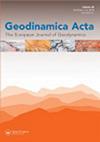Two-phased evolution of the Suşehri Basin on the North Anatolian Fault Zone, Turkey
IF 1.5
Q1 Earth and Planetary Sciences
引用次数: 4
Abstract
This study has aimed to evaluate the current tectonic structure of the Suşehri Basin located on the eastern part of the North Anatolian Fault Zone (NAFZ), one of the most important active faults in Turkey. The work extends earlier investigations of offset and seismicity on the NAFZ and tests a range of evolutionary models. In this study, buried faults have been determined from Ground penetrating radar and magnetic anomalies and possible discontinuities identified by interpolating these data in a region between Gölova and Suşehri. The discontinuities are shown to be linked to negative flower structures formed within the strike-slip fault zone. Quickbird satellite images have been used to map faults and produce kinematic analyses which show that the active stress regime is dominantly strike-slip. However, normal faults and oblique-slip faults are also observed in the basin together with strike-slip faults and the stress regime creating the strike-slip faults is shown to have formed under NW-SE directed transtension. In addition, oblique faults formed under an extensional regime with NNE-SSW direction also occur in the Suşehri Basin as subsets formed under the constraining strike-slip regime. We conclude that the Suşehri Basin started to grow as a fault wedge basin following which it transformed into a pull-apart basin by a south splay on the NAFZ so it is now dominantly a transtensional pull-apart feature.土耳其北安纳托利亚断裂带suuriehri盆地的两阶段演化
本研究旨在评价位于土耳其最重要的活动断裂之一北安那托利亚断裂带(NAFZ)东段的su ehri盆地的现今构造。这项工作扩展了对NAFZ偏移和地震活动性的早期研究,并测试了一系列演化模型。在这项研究中,通过探地雷达和磁异常确定了埋藏断层,并通过插值这些数据在Gölova和suuriehri之间的区域确定了可能的不连续面。这些不连续与走滑断裂带内形成的负花构造有关。利用Quickbird卫星图像绘制断层图并进行运动学分析,表明活动应力状态主要是走滑。盆地内还存在正断层、斜滑断层和走滑断层,形成走滑断层的应力体系是在北西-东向张拉作用下形成的。此外,在苏里盆地内还存在北北东—南南西向伸展构造下形成的斜向断裂,它们是在约束走滑构造下形成的亚群。本文认为,苏里里盆地发育初期为断楔型盆地,后因南向南伸展而转变为拉分型盆地,目前以张拉型拉分为主。
本文章由计算机程序翻译,如有差异,请以英文原文为准。
求助全文
约1分钟内获得全文
求助全文
来源期刊

Geodinamica Acta
地学-地球科学综合
CiteScore
4.50
自引率
0.00%
发文量
0
审稿时长
25 weeks
期刊介绍:
Geodinamica Acta provides an international and interdisciplinary forum for the publication of results of recent research dealing with both internal and external geodynamics. Its aims to promote discussion between the various disciplines that work on the dynamics of the lithosphere and hydrosphere. There are no constraints over themes, provided the main thrust of the paper relates to Earth''s internal and external geodynamics. The Journal encourages the submission of papers in all fields of earth sciences, such as biostratigraphy, geochemistry, geochronology and thermochronology, geohazards and their societal impacts, geomorphology, geophysics, glaciology, igneous and metamorphic petrology, magmatism, marine geology, metamorphism, mineral-deposits and energy resources, mineralogy, orogeny, palaeoclimatology, palaeoecology, paleoceanograpgy, palaeontology, petroleum geology, sedimentology, seismology and earthquakes, stratigraphy, structural geology, surface processes, tectonics (neoteoctonic, plate tectonics, seismo-tectonics, Active tectonics) and volcanism.
Geodinamica Acta publishes high quality, peer-reviewed original and timely scientific papers, comprehensive review articles on hot topics of current interest, rapid communications relating to a significant advance in the earth sciences with broad interest, and discussions of papers that have already appeared in recent issues of the journal. Book reviews are also included. Submitted papers must have international appeal and regional implications; they should present work that would be of interest to many different specialists. Geographic coverage is global and work on any part of the world is considered. The Journal also publishes thematic sets of papers on topical aspects of earth sciences or special issues of selected papers from conferences.
 求助内容:
求助内容: 应助结果提醒方式:
应助结果提醒方式:


